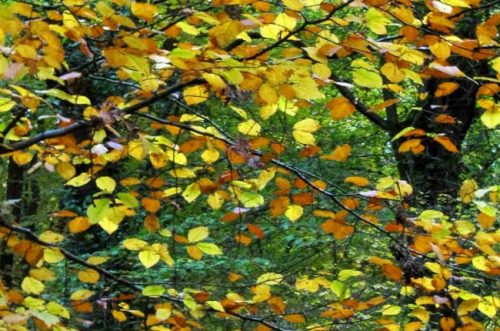from The Weatherstaff PlantingPlanner – intelligent garden design software
Misty mornings and the leaves are ochre and gold. There’s a nip in the air and the hedges are dripping with berries. Time for a spot of autumn foraging! Here are 4 vitamin-packed fruits to collect in autumn.
Elderberries
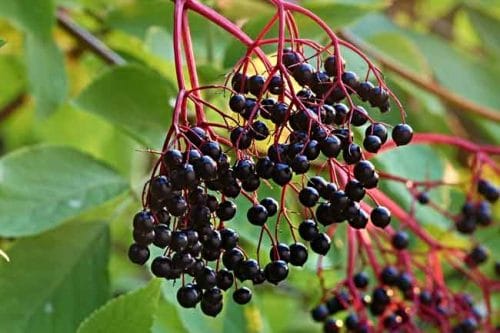
Elderberries ripen in late summer or early autumn. Pick the berries when they are fully ripe. You want them to look almost black, so if they are still green or burgundy, wait a little longer. Use a pair of scissors to snip the cluster of berries away.
Be certain you know what you are looking for as there are some poisonous lookalikes. If you need help to identify the elder tree, the Woodland Trust has some useful advice here.
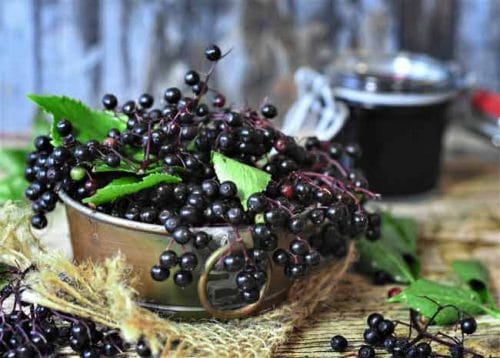
Separate the berries from the stem by running a fork along the stem. If you find some hanging on tenaciously, they may not be ripe enough. Just leave them be.
Place the berries in a large bowl of water. The unripe berries will float, enabling you to pick them out and discard. Wash and drain the berries. Pat dry.
You’re all set to start processing them, but if you prefer, you can freeze the berries until you are ready. Freezing can help to break down the berries and release the juices. Elderberries are rich in vitamin C, dietary fibre and antioxidants. They may even reduce the severity of colds and flu. But beware – the raw berries, stems and leaves are all poisonous, so if you want to use the berries to make juice, jams, chutneys or pies, they should be cooked first.
Elderberry Liqueur
750ml bottle of vodka or gin
400g elderberries
100g – 200g sugar (depending on how much of a sweet tooth you have)
Zest of half a lemon
Put the elderberries into a sterilised kilner jar. Add the sugar and lemon zest. Finally pour over the vodka or gin. Seal the jar and give it a good shake. The jar needs to be kept in a dark cupboard, while the flavours infuse. Shake the jar every couple of days for the first 2 weeks, then once a week for the next 2-3 months.
Strain the gorgeous berry-coloured liqueur into a clean bottle, using a straining funnel or a sieve lined with muslin, and you’re good to go.
Since raw elderberries are toxic, I’d be inclined to discard those boozy berries afterwards. If you want to make a liqueur that leaves you with alcohol-infused berries to add to chocolate or ice-cream, try blackberries or sloes instead.
Blackberries
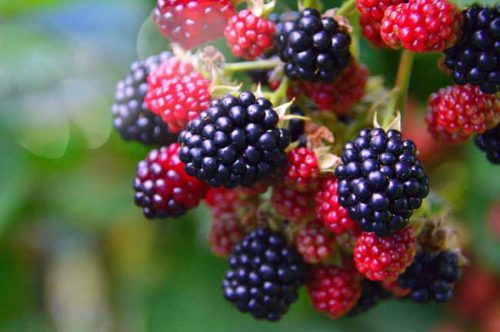
Blackberries are easy to identify and most people will have picked them at some time or other.
Blackberries contain vitamins A, C, E and most of our B vitamins. They are also a source of important nutrients and antioxidants.
They can be frozen until you are ready to use them. To avoid squishy berries, spread them out on a baking tray and pop in the freezer. Once they have frozen, you can transfer to a bag, to take up less room in the freezer.
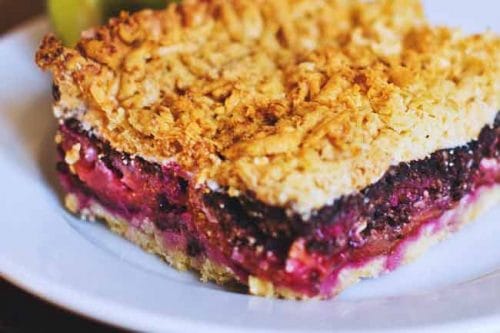
They are wonderful sprinkled over meringues or ice-cream. Cook them in pies and crumbles. Or use them in jams, chutney, wine or liqueur.
When your blackberry liqueur is ready for straining, don’t discard the alcoholic berries. Melt dark chocolate and pour over them for a delicious treat. Put them in the fridge to set and enjoy them with your coffee or give them away as a present.
Pickled blackberries
Try serving pickled blackberries with your cheese and charcuterie board for a sweet/ sour pop of flavour.
500g washed blackberries, patted dry
250g granulated sugar
125ml white or red wine vinegar
Heat the sugar and wine vinegar in a pan until the sugar is dissolved. Add the blackberries and simmer for 5 minutes. Remove the blackberries with a slotted spoon and put in a sterilised jar. Turn up the heat and boil the liquid until it becomes thick and syrupy. Pour over the fruit, making sure the blackberries are submerged in the liquid. Seal the jar and put it in a dark place for a month. Once opened, keep the pickle in the fridge and use within 2 weeks.
Sloes
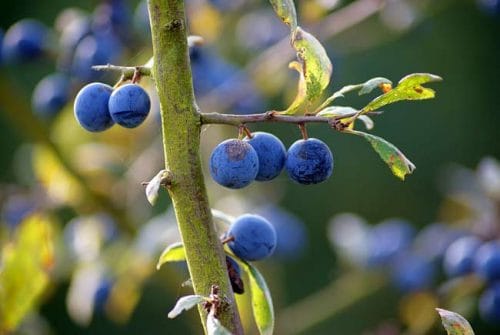
Sloes are the fruits of the blackthorn. Fresh sloes are rich in vitamin C and vitamin E. They contain nutrients such as potassium, calcium and magnesium.
Traditionally, they were picked after the first frost, so that the frost splits the skin, allowing the juices to infuse the gin more readily.
You get the same result by popping them in the freezer, so as long as the berries are ripe – a rich purple colour – you can go ahead and pick them, without waiting for temperatures to drop. If you freeze the sloes, then the skins will burst and you won’t need to prick them either. Partially defrost the sloes when you are ready to make your sloe gin. Adding a few drops of vanilla essence can give the sloe gin a more mature taste.
Rose Hips
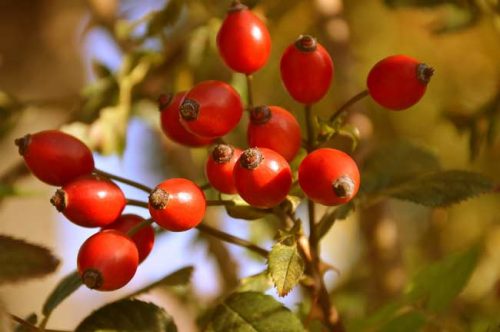
Deadheading roses encourages more flowers but if you leave the last spent flowers on the bush at the end of the season, you will allow the red seed pods to develop.
Rose hips are ornamental but also edible, with a tart flavour. They are a wonderful source of vitamin C and full of antioxidants. Rugosa roses have the largest hips and are said to have the best flavour of all.
The first touch of frost sweetens the flavour so that’s the best time to pick them. Wear garden gloves to protect yourself from thorns and snip or pick off the hips. Trim off the ends and rinse them in a colander.
It’s best to use rose hips fresh – when the vitamin levels are higher – but you can also dry them. Spread them out on a baking tray and put in an oven on a low heat until they are completely dry. Then store them in sealed jars.
The seeds of rose hips have irritating hairs. You can split the hips in half and scoop away the seeds. Or you can use the hips whole, mashing and straining the pulp through a sieve when you are ready to cook with them.
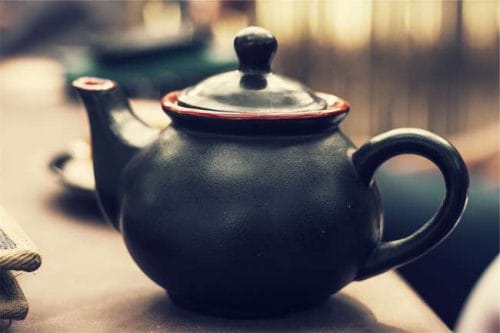
There’s no need to bother with this if you plan to make rose hip tea, as you will be filtering the tea anyway. Straining through a coffee filter will get rid of every last hair.
Rose Hip Tea
1 tablespoon fresh, mashed rose hips (or dried crumbled ones) per cup
1 cinnamon stick
Sugar or honey to sweeten, optional
Pour boiling water over the rosehips in your teapot and leave to steep for 3-5 minutes. Strain and serve.
You can also use rose hips in jams and jellies, sauces and syrups. To rehydrate dried hips, put them in a pan and cover with water. Simmer until soft, then sieve to remove the seeds.
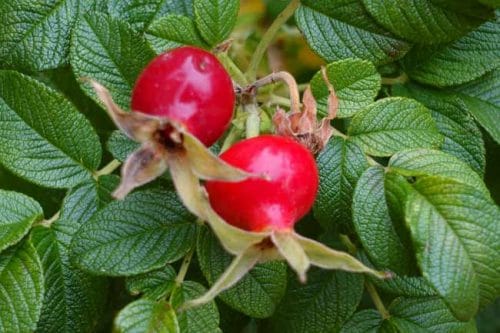
The high vitamin C content of rose hips meant that they were highly prized during the second world war.
The national diet suffered a shortage of vitamin C when the importing of fruit such as oranges was curtailed. In the autumn of 1941, boy scouts, girl guides, school teachers, the W.V.S. and other volunteers collected 200 tons of rose hips. 600,000 bottles of rose hip syrup were produced from this harvest and sold in chemists’ shops. Parents were advised to give a teaspoonful a day to young children to boost their intake of the vitamin.
Tips for Foraging
- Make sure you know what you are picking. If in doubt, leave it!
- Forage sustainably. Only pick from plentiful supplies and leave behind enough for wildlife, other foragers and for the plant itself to be able to produce seeds for the next generation.
- Avoid plants which have been treated with pesticide.
Pin for later
For more gardening ideas, click here to follow the Weatherstaff PlantingPlanner on Pinterest.


